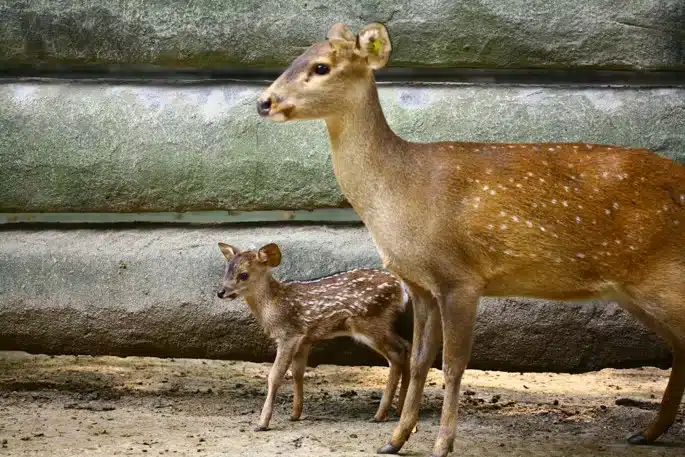About Hog deer
- It is a solitary creature but sometimes spotted feeding in small groups in open fields when food there is plentiful.
- For the most part it is sedentary and does not migrate.
- Males tend to be territorial and mark their territory with glandular secretions.
- This species exhibits sexual dimorphism. The females are slightly smaller than males and lack antlers.
- Distribution
- It has a native geographic range throughout India, including the Himalayan foothill zone and Southeast Asia, including Burma and Thailand.
- Humans have introduced free-ranging populations of this deer in Sri Lanka, Australia and the United States, including Texas, Florida, and Hawaii.
- Habitat:
- It appears to prefer dense forests; however, they are often observed in clearings, grasslands and occasionally wet grasslands.
- This variation is usually associated with time of year and food distribution.
- Conservation status
- IUCN: Endangered
- Wildlife Protection Act 1972: Scheduled I
Key facts about the Rajaji Tiger Reserve
- It is spread over three districts of Uttarakhand: Haridwar, Dehradun and Pauri Garhwal.
- It is situated along the hills and foothills of the Shiwalik ranges.
- In the year 1983, Rajaji Wildlife Sanctuary was merged with Motichur and Chilla wildlife sanctuaries and made into Rajaji National Park.
- It was named after the famous freedom fighter Rajgopalachari popularly known as “Rajaji”
- It’s location in a transition zone between temperate western Himalaya and central Himalaya enhances the species diversity.
- Vegetation: The area is covered with diverse forest types ranging from semi-evergreen to deciduous and from mixed broad-leaved to Terai grassland and has been classified as Indus-Ganges Monsoon Forest type.
- Flora: Rohini, Palash, Shisham, Sal, Sandan, Khair, Arjun, Baans, Semul, Chamaror etc.
- Fauna: Tiger and Asian Elephants. Leopard, Jungle cat and Himalayan Black Bear etc.
Q1) What are Shivalik Hills?
These are a sub-Himalayan Mountain Range running 1,600 km long from the Teesta River, Sikkim, through Nepal and India, into northern Pakistan. The range runs parallel with the Himalayan system from Haridwar on the Ganges to the banks of the Beas River. The hills have an average height of 900 to 1,200 m. They are chiefly composed of low sandstone and conglomerate hills, the solidified and up-heaved detritus of the great range in their rear, the intermediate valley lying between the outer hills and the Mussoorie.
Source: In a first, hog deer spotted inside Rajaji Tiger Reserve
Last updated on December, 2025
→ Check out the latest UPSC Syllabus 2026 here.
→ Join Vajiram & Ravi’s Interview Guidance Programme for expert help to crack your final UPSC stage.
→ UPSC Mains Result 2025 is now out.
→ UPSC Notification 2026 is scheduled to be released on January 14, 2026.
→ UPSC Calendar 2026 is released on 15th May, 2025.
→ The UPSC Vacancy 2025 were released 1129, out of which 979 were for UPSC CSE and remaining 150 are for UPSC IFoS.
→ UPSC Prelims 2026 will be conducted on 24th May, 2026 & UPSC Mains 2026 will be conducted on 21st August 2026.
→ The UPSC Selection Process is of 3 stages-Prelims, Mains and Interview.
→ UPSC Result 2024 is released with latest UPSC Marksheet 2024. Check Now!
→ UPSC Prelims Result 2025 is out now for the CSE held on 25 May 2025.
→ UPSC Toppers List 2024 is released now. Shakti Dubey is UPSC AIR 1 2024 Topper.
→ UPSC Prelims Question Paper 2025 and Unofficial Prelims Answer Key 2025 are available now.
→ UPSC Mains Question Paper 2025 is out for Essay, GS 1, 2, 3 & GS 4.
→ UPSC Mains Indian Language Question Paper 2025 is now out.
→ UPSC Mains Optional Question Paper 2025 is now out.
→ Also check Best IAS Coaching in Delhi

















